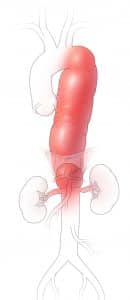- Aortic Disease
- Thoracoabdominal Aortic Aneurysm (TAAA)
Thoracoabdominal Aortic Aneurysm (TAAA)
What is TAAA?
TAAA is an enlargement or ballooning in the aorta, the main artery in the body that supplies blood to the rest of the body. TAAA occurs in the thoracic aorta, the upper section of the aorta close to the heart and chest, and extends into abdominal aorta. If left untreated, the aneurysm can rupture, leading to severe pain and lethal internal bleeding.
Symptoms of TAAA
TAAA often develops slowly over time without symptoms. Enlarged TAAA may present with the following symptoms:
- Deep and constant pain in abdomen or side of body
- Back pain
- Pulse or throbbing near the belly button
- Sudden and severe pain, which requires immediate medical attention.

What causes TAAA?
TAAA is most often caused by:
- Hardening of arteries (atherosclerosis)
- High blood pressure
- Blood vessel diseases
- Infection of the aorta
- Trauma from injury
Risk factors for developing TAAA include:
- Current or previous smokers
- Genetics or family history of aortic disease
- Age
- Race or ethnic background
- Men ages 65 to 75 should have a one-time screening for AAA
Diagnosis for TAAA
TAAA is frequently detected during examinations during other routine medical tests, such as ultrasounds of the heart or abdomen. Family history, physical exams and imaging are used to confirm TAAA. Ultrasounds, CT Scans, and MRIs are used to identify severity and location of the aneurysm, and to help assess treatment options.
Treatment for TAAA
Medical monitoring and surgery options are available for treatment. Depending on severity, age, genetic mutations, family history and other conditions, the physician or surgeon may suggest regular imaging and doctor’s appointments to monitor size, growth, and development of the aneurysm. If surgery is needed, there are two surgical options; open surgical repair and endovascular surgery.
Open surgical repair utilizes a synthetic tube (graft) to replace the aneurysmal aorta.
Endovascular surgery is performed less invasively through small incisions in the arteries in the groin area. A catheter is threaded through the artery up to the aneurysmal aorta where the stent expands to fit in the normal aortic wall above and below the aneurysm. You can discuss with your doctor which treatment option is best for you
TAAA repair is an extensive surgery done to fix aneurysms (ballooning) of the aorta that extend from the chest into the abdomen. A catheter, inserted at the start of the procedure to drain spinal fluid, relieves pressure created during surgery and reduces the risk of post-surgical paralysis. Surgical methods used by the Memorial Hermann Heart & Vascular Institute-TMC team since 1992 have dramatically reduced the incidence of paralysis from 15 percent to less than 3 percent.

